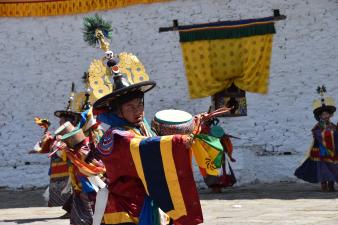EE00000017
 Zhana Ngacham: Black Hat Drum Dance
Zhana Ngacham: Black Hat Drum Dance
The name Zhana Ngacham comes from the zhana (black hats) worn by the dancers and the use of the ngachung (small drum) during the Cham performance. It is another form of Zhana Cham (black hat dance). Usually, the dance is performed mainly by monks in dzongs (fortresses), monasteries and temples during Tshechu (annual mask dance festival) and also during Drubchen (large ritual ceremonies). However, sometimes the dancers are replaced by lay people if there are no monastic facilities in the community. The dance falls under the category of Tsun cham (monastic mask dance performances).
The dancers wear a long brocade robe called phoegho with long and wide sleeve ends, a dorji gong (a crossed vajra collar) over the shoulder, and two phoe-cho or phoe-tog, a horn-like tool attached to either side of the hips that helps the robe turn smoothly and elegantly as the dancers twirl. The distinctive feature of the Black Hat dance is the black, spherical hat with decorations in the shape of a human skull and peacock quill, and Thro-pang, an angry face wrapped around the front of the abdomen.
Zhana Ngacham is usually performed by 21 dancers under the direction of Cham-pon (dance leader) and Cham-jug (deputy leader). In the seventeenth century, Zhabdrung Ngawang Namgyal (1594-1651) is revered for giving more importance to the performance of such dances and including them in the curricula of the central monastery under the title Gar-thig-yang-sum (mask dances, proportions [mandala drawing] and ritual intonation) to establish them in the field of cultural heritage in Bhutan.
Bhutan



